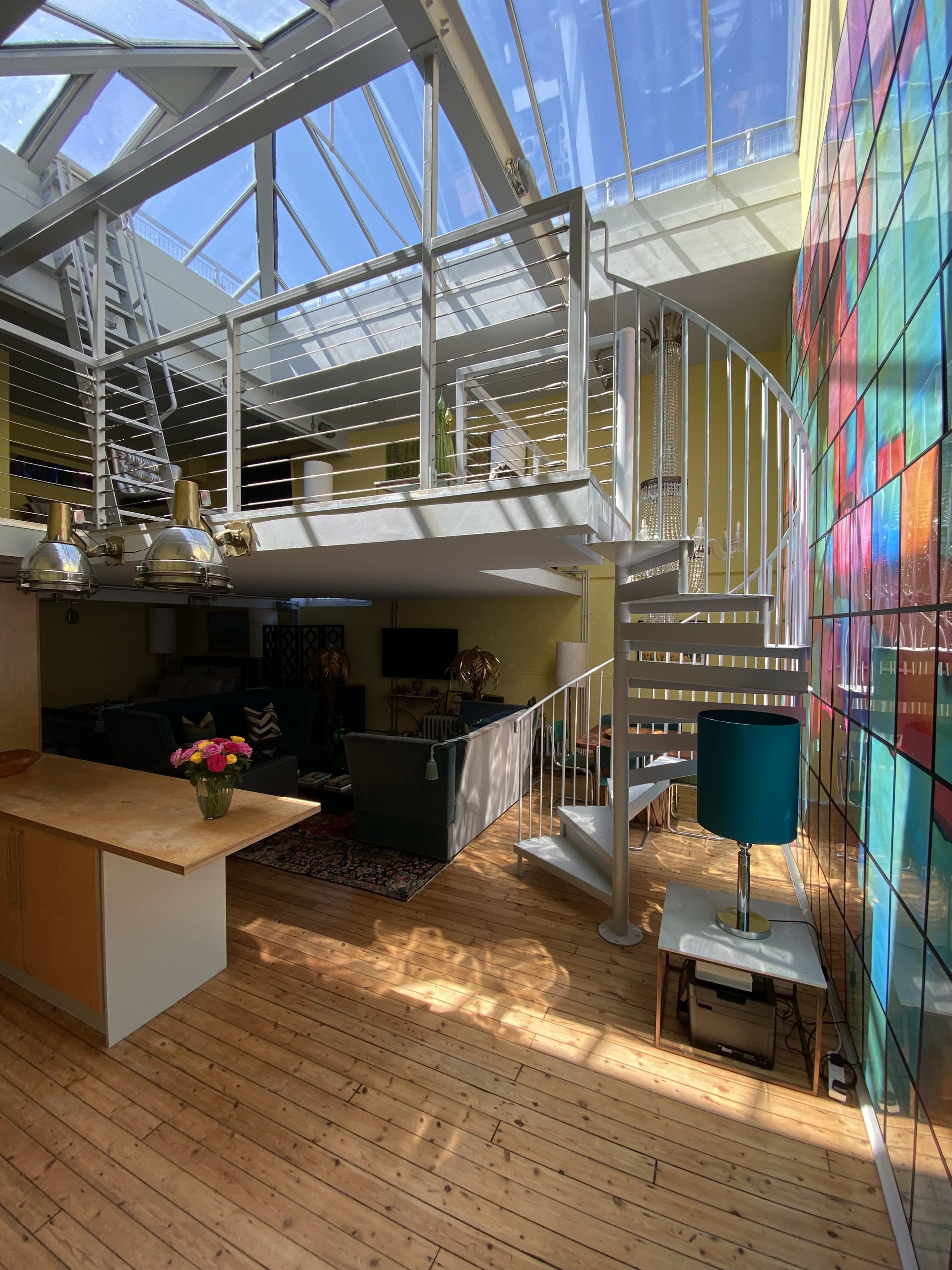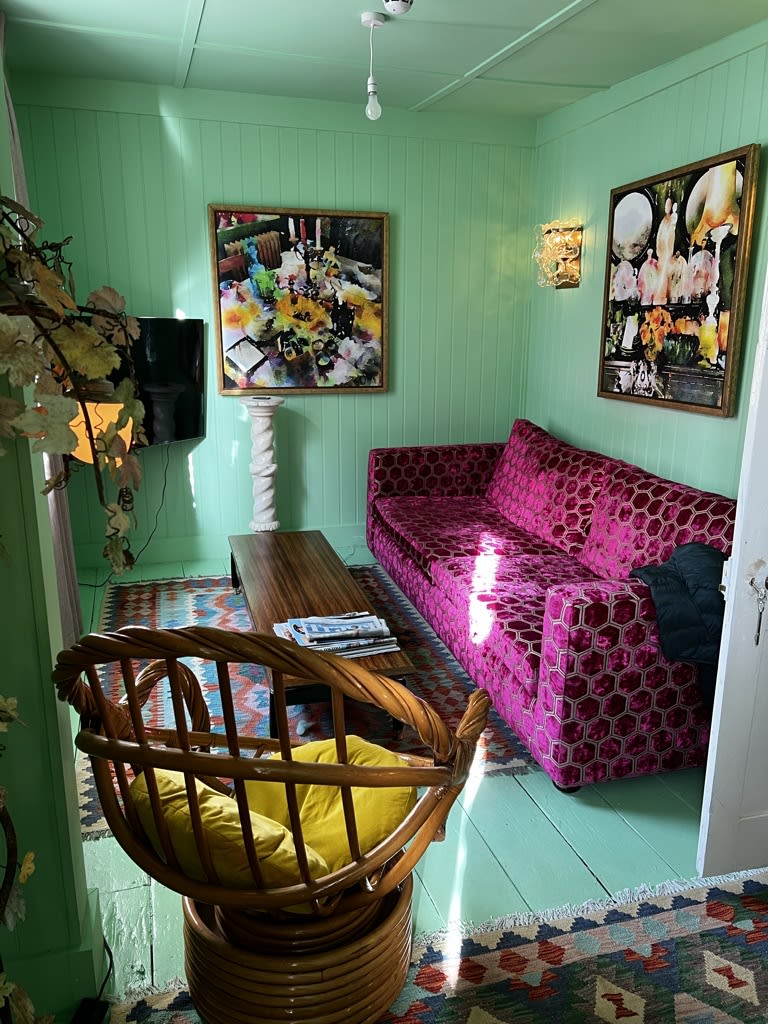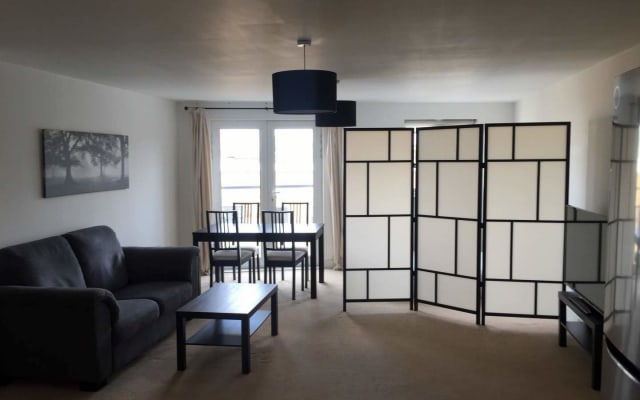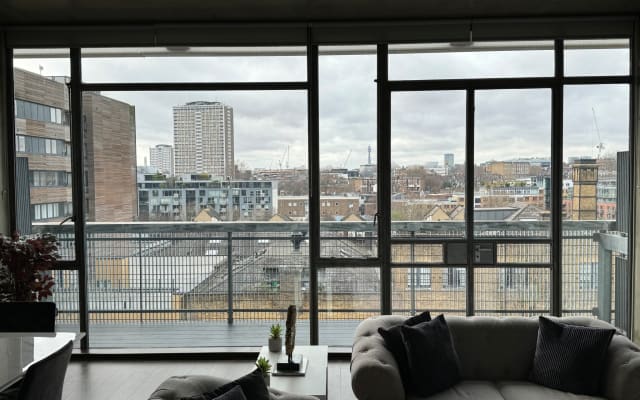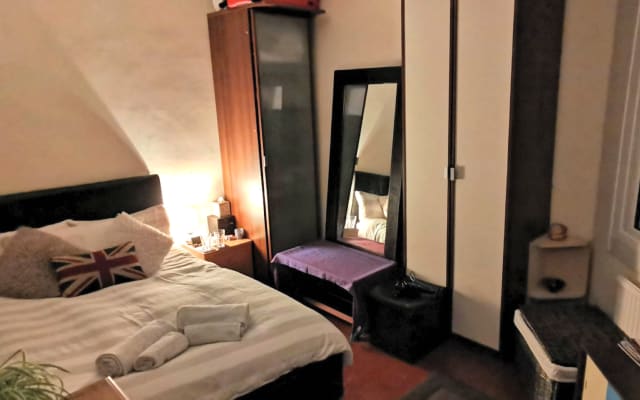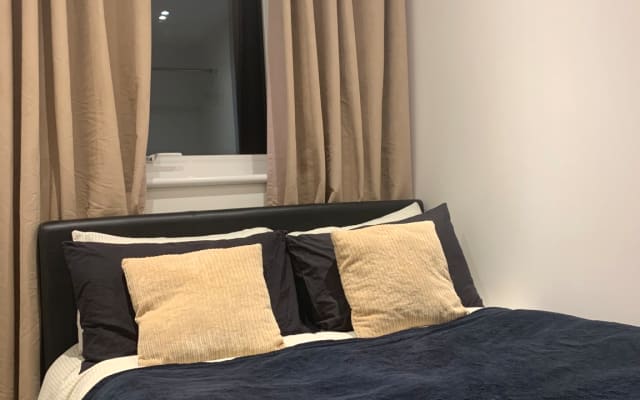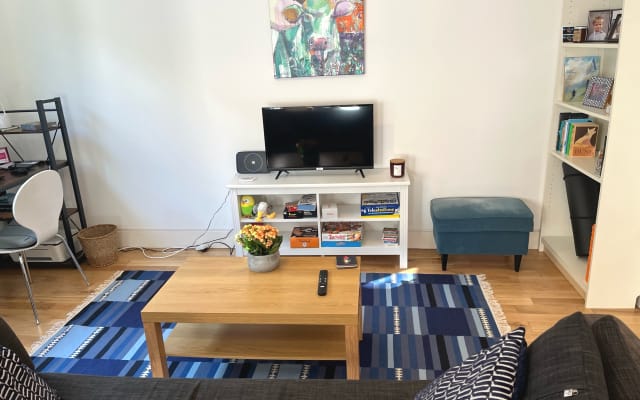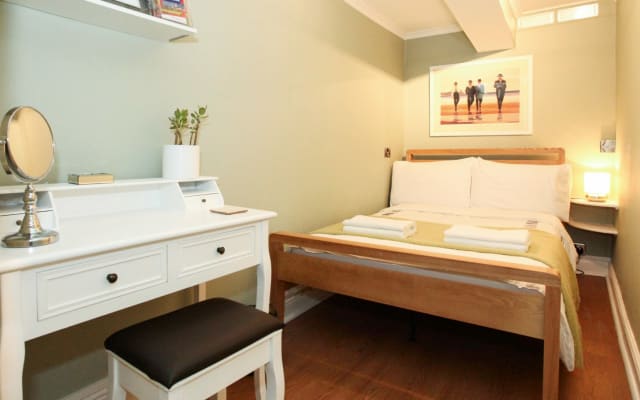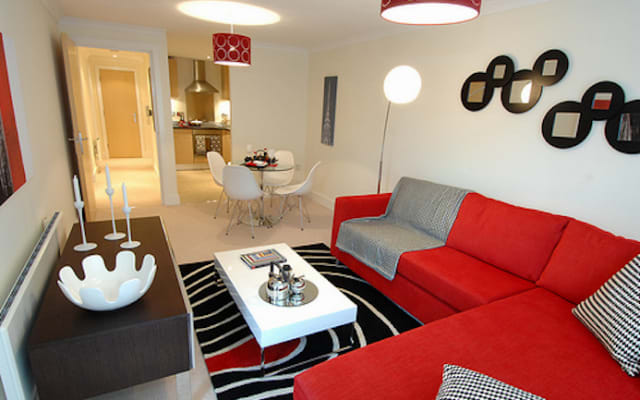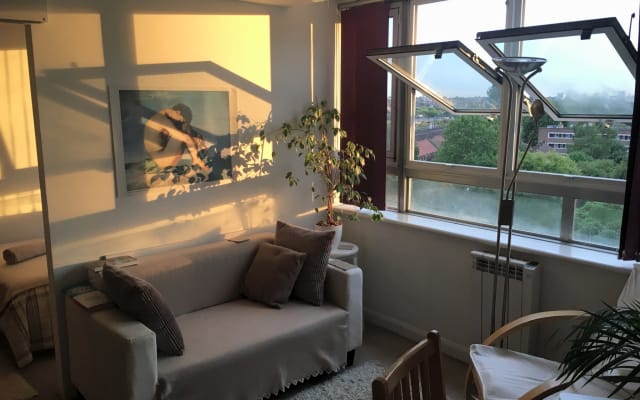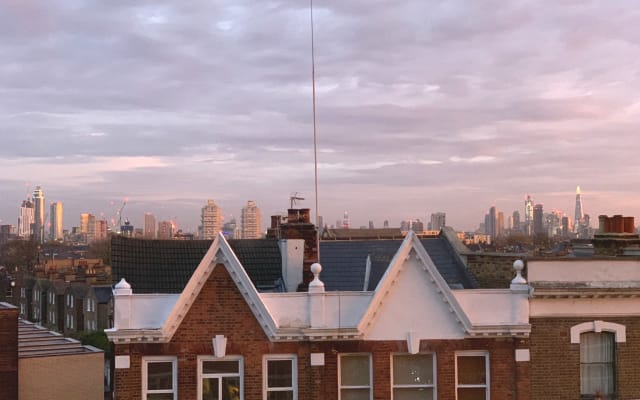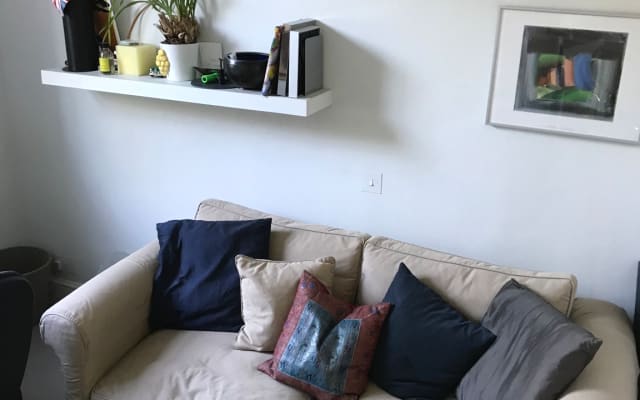-
Casa intera
-
6 ospiti
-
3 camere
-
2 bagni
-
3 letti
- Questa è una prenotazione istantanea. Chi ospita ha deciso di accettare automaticamente le richieste di prenotazione. Una volta elaborato il pagamento, la prenotazione è confermata.Prenotazione istantanea
- Wi-Fi
- Parcheggio
Perché prenotare con misterb&b?
Descrizione dell'alloggio Questo testo, inizialmente in inglese, è stato tradotto tramite un servizio di traduzione automatica e può contenere imprecisioni o errori.
This amazing double height penthouse flat sits on the top floor of this Edwardian converted school building. The space is completely open plan with the option of closing off the bedrooms ether with a pull out pocket wall or a full length dividing curtain. A huge piece of Art takes up the long wall. The space is flooded with natural light through the full size glazed roof.
Take the steps up to the private roof terrace with spectacular views over Victoria Park and the City skyline.
The space is a contemporary open plan double height loft on two floors.
The lower floor has a seating area with two Knoll sofas and boxy chair around a huge steel and glass coffee table. The kitchen is very highly specced with AEG Cooker Smeg hob, a fridge and freezer dishwasher. There is also a washer dryer. The mexican dining table with contemporary S chairs sits underneath a spectacular three meter chandelier. The bedroom with ensuite bathroom on this floor is open plan and can be closed off with a sliding door stored in a contemporary wall pocket.
Access via key access which will be arranged once booking is confirmed.
The location could not be better, directly opposite Victoria Park with 213 acres of open space. There are two cafes in the park, The Pavilion Cafe in the west and The Park Cafe in the east. There are two playgrounds, one on either side of the park, as well as sporting facilities and a skatepark in the east. The park is home to many historic artifacts and features and has decorative gardens and wilder natural areas as well as open grasslands.
Victoria Park is used as a concert venue and hosts many festivals each year. The park is approximately a mile away from the Queen Elizabeth Olympic Park. Owing to its proximity to the Olympic park, it became a venue for the BT London Live event along with Hyde Park during the London 2012 Olympic Games.
Hackney Wick
The area was part of the Ancient Parish of Hackney, which became the Metropolitan Borough of Hackney in 1900 and merged with neighbouring areas to become the London Borough of Hackney in 1965.
In the Roman period the River Lea was much wider, and the tidal estuary stretched as far as Hackney Wick. In 894, a force of Danes sailed up the river to Hertford; Alfred the Great saw an opportunity to defeat the Danes and dug a new channel to lower the level of the river, leaving the Danes stranded.[4]
Historically, Hackney Wick was an area prone to periodic flooding. The construction of the canals and relief channels on the Lea alleviated that and allowed the development of the area. In historic times, the marshes were used extensively for grazing cattle, and there was limited occupation around the 'great house' at Hackney Wick. This area as well as the marshes were historically part of Lower Homerton (also a part of the parish of Hackney). The former Hackney Brook once flowed through the area, with a confluence with the Lea a short distance to the south in Old Ford.
The area had its roots in the landholding called Wick Manor, in the parish of Hackney, which was farmed from a large building known as Wick House. In 1745 the population was limited to Wick House and a handful of cottages. There was very little urbanisation until the rapid growth of the 1860s and 1870s, which followed the arrival of the railway station.
Industrial history
The Eton Mission; until 1880 the parochial building housed rope works.
During the 19th and (early) 20th centuries, the Wick was a thriving well-populated industrial zone,[7] as the Hackney Wick First World War memorial in Victoria Park testifies, the lower part of the obelisk is densely inscribed on all four faces with the names of Wick men who died in that conflict. When Charles Booth surveyed Hackney Wick in his London-wide survey of poverty during the 1890s he would have noticed that there were, amid the noxious fumes and noise, areas of lessened deprivation.[8][9] Streets south of the railway such as Wansbeck and Rothbury Roads were a mixture of comfort and poverty. Kelday Road, right on the canal seemed positively middle class. To the north of the railway, streets either side of Wick Road, e.g. Chapman Road, Felstead Street and Percy Terrace were described as "very poor", with "chronic want".
It was no doubt conditions such as these which hastened the involvement of Eton College about this time to instigate their urban mission in Hackney Wick, a philanthropic and perhaps more accurately pedagogical outreach shared with several other public schools. The Eton Mission lasted from 1880 to 1971 when the college decided that a more local social project was appropriate for changed times, and has left as legacy a fine church by G. F. Bodley, a noted rowing club, and the 59 Club.
In the last quarter of the eighteenth century, water mills on the Hackney Brook were adapted for the manufacturer of silk, and in particular crêpe. In 1811, it was said that 'the works at these mills are moved by two steam engines, on an improved principle, which set in motion 30,000 spindles, besides numerous other implements of machinery used in the manufacture.'
The world's first true synthetic plastic, parkesine, invented by Alexander Parkes, was manufactured here from 1866 to 1868, though Parkes' company failed due to high production costs. In contrast shellac, a natural polymer was manufactured at the Lea Works by A.F. Suter and Co. at the Victory Works for many years. The factory at nos 83/4 Eastway commenced operation in 1927. Subsequently, they relocated to Dace Road in Bow.[13] For many years Hackney Wick was the location of the oil distiller Carless, Capel & Leonard, credited with introduction of the term petrol in the 1890s.[14] The distinguished chemist and academic Sir Frederick Warner ********) worked at Carless's Hackney Wick factory from 1948 to 1956.[15] William J Leonard (1857–1923) was followed by his son Julian Mayard Leonard (1900–1978) into the firm, where he became managing director and deputy chairman.[16]
The firm of Brooke Simpson Spiller at Atlas Works in Berkshire Road had taken over the firm of William Henry Perkin at Greenford Green near Harrow in 1874, but subsequently disposed of some operations to Burt Bolton Heywood in Silvertown.[17] Nevertheless, Brooke Simpson Spiller is the successor company to the founding father of the British Dyestuff Industry.[18] The company employed the brilliant organic chemist Arthur George Green (1864–1941) from 1885 until 1894, when he left to join the Clayton Aniline Company in Manchester and ultimately, when the British chemical industry failed his talents, to the chair of Colour Chemistry at Leeds University. At Hackney Wick, Green discovered the important dyestuff intermediate Primuline. He was a contemporary of the organic chemist Richard John Friswell (1849–1908) who was from 1874 a research chemist, and from 1886 until 1899 director and chemical manager. Perhaps even more distinguished was the Jewish chemist, Professor Raphael Meldola FRS, who is remembered for Meldola's Blue dye and is commemorated by the Royal Society of Chemistry's Meldola Medal. He worked at Hackney Wick from 1877 until 1885,[19] where Meldola's Blue was discovered.[20][21] Friswell went on to succeed Armstrong as Professor of Chemistry at Finsbury Technical College.[22] Friswell eventually left Hackney Wick to work for the British Uralite Company at Higham although he was still a director there in 1893 when he wrote to H.E. Armstrong to describe bad trading conditions at Atlas Works.[23] A large collection of Hackney made dyestuffs is on view at the Powerhouse Museum in Sydney Australia.[24] The firm of W.C.Barnes of the Phoenix Works was also engaged in the aniline dye industry at Hackney Wick.
The confectioner Clarnico is synonymous with Hackney Wick. The company, known as Clarke, Nickolls, Coombs until 1946, arrived in Hackney Wick in 1879.[25][26] Despite being taken over by Trebor Bassett, the name lives on in Bassett's Clarnico Mint Creams[27] and also in the CNC Property company.[28] Just after the second world war, Clarnico was the largest confectioner in Britain but moved further across the Lea to Waterden Road in 1955 where it survived for another 20 years. The company had its own brass band in the early 20th century.
Another pathfinding entrepreneur in Hackney Wick was the Frenchman, Eugene Serre. His father, Achille Serre, who had settled in Stoke Newington, introduced dry cleaning to England.[29][30] Eugene expanded the business into a former tar factory in White Post Lane which still carries traces of the firm's name.
Post Industrial history[edit]
River Lee Navigation, off White Post Lane.
In post-industrial times, Hackney Wick has seen many changes to its topography. Very little remains of the inter-war street pattern between the Hertford Union Canal and Eastway (the western part was then known as Gainsborough Road) or the masses of small terraced houses. Many of the street names have permanently vanished due to later redevelopment. Part of the Wick was redeveloped in the 1960s to create the Greater London Council's Trowbridge Estate, which consisted of single-storey modern housing at the foot of seven 21-storey tower blocks.[31] The estate's housing conditions deteriorated quickly and despite an attempt to regenerate the tower blocks,[32] much of the housing in the estate was replaced between ********. The artist Rachel Whiteread made screenprints of photographs of the former Trowbridge estate which are in the Tate Collection as part of her series Demolished.[33]
The Atlas Works of 1863, backing onto the Lee Navigation, was demolished to make way for housing in the 1990s.[34] In the 1930s it had been the home of the British Perforated Paper Co, famous for inventing toilet paper in 1880.
Great public transport Hub via Homerton Overground station, busses
This amazing double height penthouse flat sits on the top floor of this Edwardian converted school building. The space is completely open plan with the option of closing off the bedrooms ether with a pull out pocket wall or a full length dividing curtain. A huge piece of Art takes up the long wall. The space is flooded with natural light through the full size glazed roof.
Take the steps up to the private roof terrace with spectacular views over Victoria Park and the City skyline.
The space is a contemporary open plan double height loft on two floors.
The lower floor has a seating area with two Knoll sofas and boxy chair around a huge steel and glass coffee table. The kitchen is very highly specced with AEG Cooker Smeg hob, a fridge and freezer dishwasher. There is also a washer dryer. The mexican dining table with contemporary S chairs sits underneath a spectacular three meter chandelier. The bedroom with ensuite bathroom on this floor is open plan and can be closed off with a sliding door stored in a contemporary wall pocket.
Access via key access which will be arranged once booking is confirmed.
The location could not be better, directly opposite Victoria Park with 213 acres of open space. There are two cafes in the park, The Pavilion Cafe in the west and The Park Cafe in the east. There are two playgrounds, one on either side of the park, as well as sporting facilities and a skatepark in the east. The park is home to many historic artifacts and features and has decorative gardens and wilder natural areas as well as open grasslands.
Victoria Park is used as a concert venue and hosts many festivals each year. The park is approximately a mile away from the Queen Elizabeth Olympic Park. Owing to its proximity to the Olympic park, it became a venue for the BT London Live event along with Hyde Park during the London 2012 Olympic Games.
Hackney Wick
The area was part of the Ancient Parish of Hackney, which became the Metropolitan Borough of Hackney in 1900 and merged with neighbouring areas to become the London Borough of Hackney in 1965.
In the Roman period the River Lea was much wider, and the tidal estuary stretched as far as Hackney Wick. In 894, a force of Danes sailed up the river to Hertford; Alfred the Great saw an opportunity to defeat the Danes and dug a new channel to lower the level of the river, leaving the Danes stranded.[4]
Historically, Hackney Wick was an area prone to periodic flooding. The construction of the canals and relief channels on the Lea alleviated that and allowed the development of the area. In historic times, the marshes were used extensively for grazing cattle, and there was limited occupation around the 'great house' at Hackney Wick. This area as well as the marshes were historically part of Lower Homerton (also a part of the parish of Hackney). The former Hackney Brook once flowed through the area, with a confluence with the Lea a short distance to the south in Old Ford.
The area had its roots in the landholding called Wick Manor, in the parish of Hackney, which was farmed from a large building known as Wick House. In 1745 the population was limited to Wick House and a handful of cottages. There was very little urbanisation until the rapid growth of the 1860s and 1870s, which followed the arrival of the railway station.
Industrial history
The Eton Mission; until 1880 the parochial building housed rope works.
During the 19th and (early) 20th centuries, the Wick was a thriving well-populated industrial zone,[7] as the Hackney Wick First World War memorial in Victoria Park testifies, the lower part of the obelisk is densely inscribed on all four faces with the names of Wick men who died in that conflict. When Charles Booth surveyed Hackney Wick in his London-wide survey of poverty during the 1890s he would have noticed that there were, amid the noxious fumes and noise, areas of lessened deprivation.[8][9] Streets south of the railway such as Wansbeck and Rothbury Roads were a mixture of comfort and poverty. Kelday Road, right on the canal seemed positively middle class. To the north of the railway, streets either side of Wick Road, e.g. Chapman Road, Felstead Street and Percy Terrace were described as "very poor", with "chronic want".
It was no doubt conditions such as these which hastened the involvement of Eton College about this time to instigate their urban mission in Hackney Wick, a philanthropic and perhaps more accurately pedagogical outreach shared with several other public schools. The Eton Mission lasted from 1880 to 1971 when the college decided that a more local social project was appropriate for changed times, and has left as legacy a fine church by G. F. Bodley, a noted rowing club, and the 59 Club.
In the last quarter of the eighteenth century, water mills on the Hackney Brook were adapted for the manufacturer of silk, and in particular crêpe. In 1811, it was said that 'the works at these mills are moved by two steam engines, on an improved principle, which set in motion 30,000 spindles, besides numerous other implements of machinery used in the manufacture.'
The world's first true synthetic plastic, parkesine, invented by Alexander Parkes, was manufactured here from 1866 to 1868, though Parkes' company failed due to high production costs. In contrast shellac, a natural polymer was manufactured at the Lea Works by A.F. Suter and Co. at the Victory Works for many years. The factory at nos 83/4 Eastway commenced operation in 1927. Subsequently, they relocated to Dace Road in Bow.[13] For many years Hackney Wick was the location of the oil distiller Carless, Capel & Leonard, credited with introduction of the term petrol in the 1890s.[14] The distinguished chemist and academic Sir Frederick Warner ********) worked at Carless's Hackney Wick factory from 1948 to 1956.[15] William J Leonard (1857–1923) was followed by his son Julian Mayard Leonard (1900–1978) into the firm, where he became managing director and deputy chairman.[16]
The firm of Brooke Simpson Spiller at Atlas Works in Berkshire Road had taken over the firm of William Henry Perkin at Greenford Green near Harrow in 1874, but subsequently disposed of some operations to Burt Bolton Heywood in Silvertown.[17] Nevertheless, Brooke Simpson Spiller is the successor company to the founding father of the British Dyestuff Industry.[18] The company employed the brilliant organic chemist Arthur George Green (1864–1941) from 1885 until 1894, when he left to join the Clayton Aniline Company in Manchester and ultimately, when the British chemical industry failed his talents, to the chair of Colour Chemistry at Leeds University. At Hackney Wick, Green discovered the important dyestuff intermediate Primuline. He was a contemporary of the organic chemist Richard John Friswell (1849–1908) who was from 1874 a research chemist, and from 1886 until 1899 director and chemical manager. Perhaps even more distinguished was the Jewish chemist, Professor Raphael Meldola FRS, who is remembered for Meldola's Blue dye and is commemorated by the Royal Society of Chemistry's Meldola Medal. He worked at Hackney Wick from 1877 until 1885,[19] where Meldola's Blue was discovered.[20][21] Friswell went on to succeed Armstrong as Professor of Chemistry at Finsbury Technical College.[22] Friswell eventually left Hackney Wick to work for the British Uralite Company at Higham although he was still a director there in 1893 when he wrote to H.E. Armstrong to describe bad trading conditions at Atlas Works.[23] A large collection of Hackney made dyestuffs is on view at the Powerhouse Museum in Sydney Australia.[24] The firm of W.C.Barnes of the Phoenix Works was also engaged in the aniline dye industry at Hackney Wick.
The confectioner Clarnico is synonymous with Hackney Wick. The company, known as Clarke, Nickolls, Coombs until 1946, arrived in Hackney Wick in 1879.[25][26] Despite being taken over by Trebor Bassett, the name lives on in Bassett's Clarnico Mint Creams[27] and also in the CNC Property company.[28] Just after the second world war, Clarnico was the largest confectioner in Britain but moved further across the Lea to Waterden Road in 1955 where it survived for another 20 years. The company had its own brass band in the early 20th century.
Another pathfinding entrepreneur in Hackney Wick was the Frenchman, Eugene Serre. His father, Achille Serre, who had settled in Stoke Newington, introduced dry cleaning to England.[29][30] Eugene expanded the business into a former tar factory in White Post Lane which still carries traces of the firm's name.
Post Industrial history[edit]
River Lee Navigation, off White Post Lane.
In post-industrial times, Hackney Wick has seen many changes to its topography. Very little remains of the inter-war street pattern between the Hertford Union Canal and Eastway (the western part was then known as Gainsborough Road) or the masses of small terraced houses. Many of the street names have permanently vanished due to later redevelopment. Part of the Wick was redeveloped in the 1960s to create the Greater London Council's Trowbridge Estate, which consisted of single-storey modern housing at the foot of seven 21-storey tower blocks.[31] The estate's housing conditions deteriorated quickly and despite an attempt to regenerate the tower blocks,[32] much of the housing in the estate was replaced between ********. The artist Rachel Whiteread made screenprints of photographs of the former Trowbridge estate which are in the Tate Collection as part of her series Demolished.[33]
The Atlas Works of 1863, backing onto the Lee Navigation, was demolished to make way for housing in the 1990s.[34] In the 1930s it had been the home of the British Perforated Paper Co, famous for inventing toilet paper in 1880.
Great public transport Hub via Homerton Overground station, busses
Recensisci per primo questa proprietà!
Gli host si sono impegnati per presentare al meglio l’alloggio Ora le loro case sono pronte per ospitarti e non vedono l'ora di accoglierti come loro primo ospite misterb&b!Info sull'host
Dal momento che l'essere gay fa parte del nostro DNA, chiediamo ad ogni agenzia di confermare un atteggiamento di accoglienza e accettazione nei confronti della nostra comunità accettando la tabella sotto:
Regole della proprietà Questo testo, inizialmente in inglese, è stato tradotto tramite un servizio di traduzione automatica e può contenere imprecisioni o errori.
Condizioni
Termini di cancellazione


Puoi contattare Paul attraverso il pulsante Contatta su questa pagina. Se hai già prenotato, clicca I miei viaggi.
Connettiti alla comunità gay globale quando viaggi. misterb&b garantisce pagamenti sicuri. , Nessuna prenotazione, e un servizio clienti a tua disposizione.
Chiedere il deposito cauzionale è a cura dell'host. Se l'importo della cauzione appare sulla pagina dell'annuncio, la quota si troverà sotto alla tariffa giornaliera.
Quando la prenotazione verrà finalizzata riceverai una mail di conferma con i contatti del tuoi host. Accedi a misterb&b e clicca su I miei viaggi. Troverai qui lo status e i dettagli di tutte le tue prenotazioni e richieste d'alloggio.
Di più sulla Londra gay
